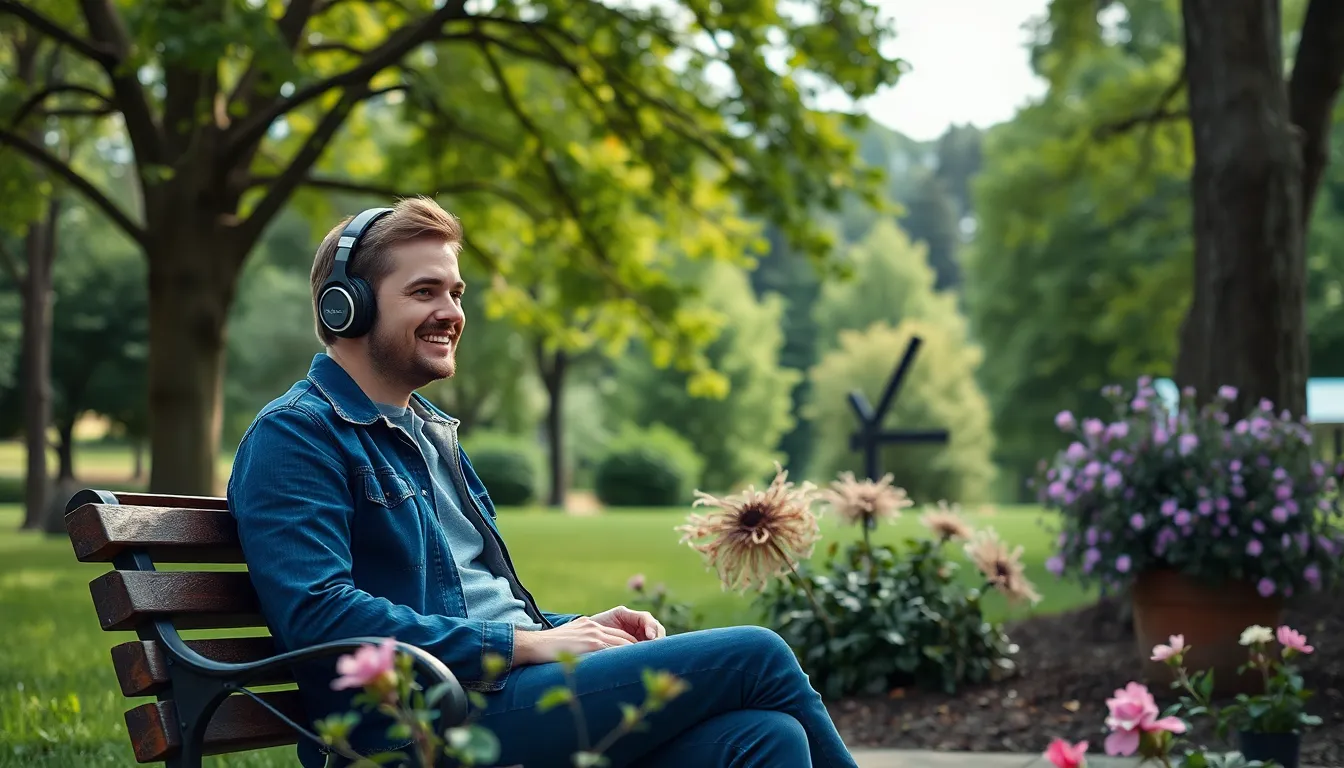Table of Contents
ToggleIn a world overflowing with distractions, the subtle art of ambient sound capture offers a refreshing escape. Imagine strolling through a bustling city, the gentle rustle of leaves, or the soothing sound of waves lapping at the shore. These sounds can transport anyone to a different place, creating a rich tapestry of experiences. But what if you could bottle up those moments and revisit them anytime?
Overview of Ambient Sound Capture
Ambient sound capture refers to the process of recording sounds from the environment, such as nature or urban settings. Such recordings serve multiple purposes, including relaxation, focus enhancement, and memory stimulation. Individuals seek out these sounds to escape the noise of everyday life.
Microphones designed for capturing ambient sound play a crucial role. These devices can range from simple handheld recorders to professional-grade audio equipment. Many sound artists and sound designers utilize high-quality microphones to create intricate soundscapes.
Different environments offer unique auditory experiences. For example, the sounds of a forest may include rustling leaves and chirping birds, while an urban setting might feature honking cars and distant chatter. Each environment provides a distinct auditory palette that can transport listeners back to specific places and moments.
Accessibility has increased due to advancements in technology. Smartphones now come equipped with built-in microphones, allowing individuals to easily record and share ambient sounds. Many users turn to mobile apps dedicated to sound recording, enhancing the overall experience of capturing their surroundings.
Consistency in sound quality remains vital. Factors such as wind, humidity, and equipment type can affect the final recording. To achieve optimal results, sound capturers often choose quieter times and locations for their recordings.
Capturing ambient sound becomes more relevant in therapeutic contexts. Many practitioners incorporate these sounds into mindfulness and relaxation practices. The soothing effects of nature sounds contribute significantly to stress relief and emotional well-being.
Understanding the impact of ambient sound can lead to new ways of engaging with the environment. Ultimately, each sound captured adds to a growing library of experiences, helping individuals reconnect with the world around them.
Importance of Ambient Sound Capture

Ambient sound capture plays a crucial role in creating a deeper connection with one’s surroundings. By recording the sounds of various environments, individuals can enhance their experiences and foster well-being.
Applications in Various Fields
Education benefits significantly from ambient sound capture, enriching learning environments through soundscapes that stimulate focus. This approach enhances creativity in artistic fields, where sound designers use environmental audio to craft immersive experiences. In film and media, background sounds set the tone and provide authentic ambiance, enhancing storytelling. Moreover, virtual reality applications incorporate ambient sounds for realistic simulations, allowing users to engage more fully with digital environments.
Impact on Mental Health and Well-being
Captured ambient sound contributes to mental health by promoting relaxation and mindfulness. Many therapeutic practices integrate these sounds, facilitating stress relief and emotional stability. Research shows that nature sounds can reduce anxiety and improve mood, making them valuable in settings like therapy or meditation. Listening to familiar ambient sounds can evoke positive memories, fostering a sense of comfort and belonging. Sound therapy programs utilize specific recordings to target relaxation responses, helping individuals manage their mental well-being effectively.
Techniques and Technologies Used
Capturing ambient sound effectively involves various techniques and technologies that enhance audio quality and experience. Understanding these components provides insight into the art of sound recording.
Microphone Types and Placement
Different types of microphones serve distinct purposes in ambient sound capture. Condenser microphones, for instance, excel at picking up nuanced details found in natural settings. Dynamic microphones offer robust performance in louder environments. In addition, lavalier microphones provide discreet capturing, making them ideal for recording sounds in crowded places. Proper placement significantly impacts audio quality as well. Positioning microphones close to sound sources strengthens signal clarity. Using multiple microphones helps create a more immersive soundscape by capturing different auditory perspectives, broadening the listening experience.
Software for Sound Analysis
Various software tools facilitate sound analysis and editing, enhancing the overall quality of captured audio. Programs like Audacity, allowing for detailed waveform editing, provide users with options to refine sounds. Other applications, such as Adobe Audition, offer advanced features for mixing and enhancing specific frequencies. Sound analysis software can visualize sound waves, enabling users to identify frequency ranges and noise levels. Many professionals incorporate these tools to monitor environmental noise and adjust recording settings effectively. By utilizing the right software, users ensure that ambient sounds resonate accurately, preserving the essence of each unique environment.
Challenges and Limitations
Ambient sound capture faces distinct challenges that can impact the quality and effectiveness of recordings.
Environmental Factors
Wind can distort sound waves, leading to unwanted noise during recordings. Humidity changes can also affect microphone performance, resulting in variations in sound quality. Background sounds, including traffic or construction noise, may overshadow desired ambient sounds. These challenges vary by location, making it essential to choose recording environments carefully. The time of day can present additional factors as well; early mornings may yield clearer recordings in nature, while urban sounds peak during the day. Microphone placement plays a crucial role, as close proximity to the desired source minimizes interference. Choosing the right microphone type can also mitigate environmental impacts for different settings.
Ethical Considerations
Consent is a pivotal ethical consideration in ambient sound capture. Recording in public spaces requires awareness; individuals may not expect to be included in ambient recordings. Respect for personal privacy remains paramount, especially in residential areas where distinct sounds emerge. Using sound recordings in commercial projects necessitates careful consideration of copyright and ownership issues. Ethical best practices involve transparent communication with subjects and obtaining consent whenever possible. Exploring the intent behind capturing specific sounds encourages responsible use, ensuring that ambient sound contributes positively to the intended purpose. Documenting these ethical considerations helps maintain integrity in the practice of ambient sound capture.
Future Trends in Ambient Sound Capture
Technological innovations drive the evolution of ambient sound capture. Emerging tools enhance recording quality, making it easier to achieve professional results with accessible devices. Smart microphones equipped with noise-canceling features reduce interference from surrounding sounds, facilitating clearer recordings.
Artificial intelligence now plays a pivotal role in sound editing. AI algorithms analyze ambient noise, automatically optimizing recordings for clarity and richness. Additionally, machine learning enables personalized sound experiences, tailoring ambient sounds to individual preferences.
Integration with virtual reality environments creates immersive auditory experiences. Users engage with soundscapes that adapt in real-time to their actions within a digital landscape. Such advancements enhance gaming, therapy, and educational applications, offering rich, interactive experiences.
Advancements in mobile applications continue to make sound capture more user-friendly. Intuitive interfaces allow even amateur sound recorders to produce high-quality soundscapes. User-generated content on platforms dedicated to ambient sounds is on the rise, fostering collaborative creativity and exploration.
Ethical considerations also gain prominence in future trends. As capturing sounds in public spaces becomes commonplace, awareness regarding privacy issues is paramount. Ensuring consent and respecting personal boundaries remain key in developing responsible sound recording practices.
Environmental sustainability influences future ambient sound projects. Recording teams explore eco-friendly equipment and techniques to minimize their ecological footprint. Sustainable practices not only benefit the environment but also resonate with audiences increasingly aware of ethical consumption.
Altogether, these trends highlight a future where ambient sound capture evolves alongside technological advancements and societal values, enriching personal experiences and encouraging deeper connections with the world.
Ambient sound capture offers a unique way to connect with the world and enhance well-being. By recording everyday sounds, individuals can create personal soundscapes that evoke memories and foster relaxation. As technology advances, the accessibility and quality of sound capture improve, allowing more people to explore this enriching practice.
The importance of ethical considerations and environmental awareness in sound recording cannot be overstated. As the field evolves, it will continue to play a vital role in various domains, from therapy to education and the arts. Embracing ambient sound capture opens doors to deeper connections with surroundings and can transform everyday experiences into meaningful auditory journeys.







